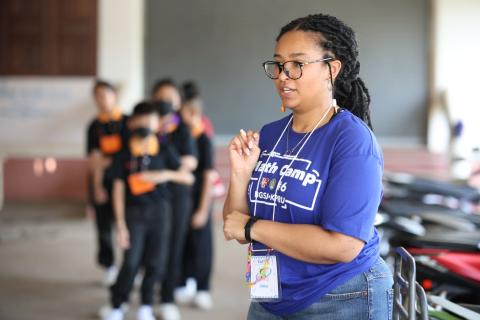To teach math stateside, Ohio student teachers go abroad

Gabriel Matney has been teaching mathematics in the United States for decades, but he knows some of the best ideas can come from other countries.
Matney is a professor of math education at Bowling Green State University and president of the Ohio Council of Teachers of Mathematics. Since 2013, he has taken his BGSU math education students abroad to places like Fiji, China, and New Zealand to learn new ideas about math education.
“There are ways that mathematics education might be done differently, right?” Matney said.
Matney’s most recent trips were to Malawi and Thailand. On both trips, his BGSU students worked with local teachers or teacher candidates to plan and study lessons, teach local students, and run math camps – day camps meant to make math fun.
“The goal of math camp is to give students an experience in thinking, learning, and socializing about mathematics that has them walk away from camp thinking, well, mathematics isn't so bad, actually,” Matney said.
Math Camp is one idea that he brought back to America. He started BGSU’s middle school Math Camp program in 2013 after traveling to Thailand to research their camps. He asked one teacher why they held the events year-round.
“[What] the professor said to me was, well, in Thailand, our students don't like to learn math, so we have to do these things to help them love it more,” Matney said. “And I just kind of got this big smile on my face. I said, 'Oh, so in the U.S., you think students love to learn math?'”
It was a point of connection.
BGSU graduate student KimAnn Brown went on the recent Malawi trip and discovered the same: “Students are students, no matter where you go.”
In Malawi, the BGSU group visited community schools, day schools and private schools.
She says that trip – and her next one to Thailand – turned out to be less about math, and more about life lessons and making connections.
“It was about perspective and opening your mind and in teaching – teaching is an open minded profession, or at least it should be,” she said.

Ohio State University Professor of Mathematics Education Theodore Chao thinks that sort of open-mindedness is exactly what teachers-in-training need to learn.
“It's really hard to get math teachers to think beyond the way they were taught,” Chao said.
Chao has done his own overseas education research, including in Vietnam and Indonesia. He points to empathy is a critical component of teaching and said while there’s no one right way to teach math, there might be a best way.
“Primarily, I think that mathematics is best taught by listening and understanding the people you're working with,” Chao said.
Chao said in the United States, math is often taught by people who excelled at it when they were young, and they don’t always understand what it’s like to struggle or have “mathematics trauma,” from bad childhood math experiences.
Putting teachers in a classroom where students are learning math in a different way or there is a language barrier can help change that.
BGSU graduate student Brown knows all about language barriers now. She said in Malawi most students and teachers spoke some English, but in Thailand, despite learning English in school, most people she interacted with were not fluent. Communication with the Thai teacher candidates could even be challenging.
“So, we had to use a lot of body language and Google Translate…but I actually found it more meaningful because I had to find new and different ways to communicate with them,” Brown said.
Matney noted that while the language barrier could be steep, communication is a little bit easier with a subject like math because most basic ideas behind it are universal and its notions and notations are widely understood.
“That doesn't mean there's not diversity in mathematical thought or creativity mathematical thought. But what it says is there's a high potential for connectivity in this subject area across cultures,” Matney said.
In other words, you can speak math with people no matter their language.
9(MDYwODMwNTczMDE2ODk5NTExNDAyNzM5Ng000))
- Home
- Schedules
- TV
- TV
- Local TV Programs
- Business | Life 360 with Kristi K.
- Toledo Stories
- To The Point with Doni Miller
- Listening with Keith Burris
- Ideas & Insights
- WGTE Presents
- BL360: Northwest Ohio Innovation Consortium
- Magic of the Old West End
- Freedom Means Never Surrender
- I&I: The Random Factor
- FF: National Cherry Festival
- TTP: Moms Demand Action For Gun Sense in America
- Watch Live
- Radio
- Education
- Community
- Support
- About
- Donate
- Watch Live


